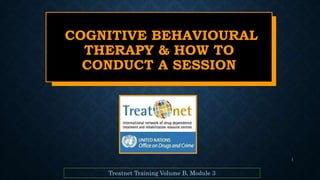
Clinicians Role and how to Conduct a CBT Session
- 1. 1 COGNITIVE BEHAVIOURAL THERAPY & HOW TO CONDUCT A SESSION Treatnet Training Volume B, Module 3
- 2. 2 WHAT IS CBT AND HOW IS IT USED IN ADDICTION TREATMENT? • CBT is a form of “talk therapy” that is used to teach, encourage, and support individuals about how to reduce/stop their harmful drug use. • CBT provides skills that are valuable in assisting people in gaining initial abstinence from drugs (or in reducing their drug use). • CBT also provides skills to help people sustain abstinence (relapse prevention).
- 4. IMPORTANT CONCEPTS IN CBT (1) In the early stages of CBT treatment, strategies stress on behavioural change. Strategies include: • Planning time to engage in non-drug related behaviour • Avoiding or leaving a high risk situations. 4
- 5. IMPORTANT CONCEPTS IN CBT (2) CBT attempts to help clients: • Follow a planned schedule of low-risk activities • Recognise drug use (high-risk) situations and avoid these situations • Cope more effectively with a range of problems and problematic behaviours associated with using 5
- 6. IMPORTANT CONCEPTS IN CBT (3) As CBT treatment continues into later phases of recovery, more emphasis is given to the “cognitive” part of CBT. This includes: • Teaching clients knowledge about addiction • Teaching clients about conditioning, triggers, and craving • Teaching clients cognitive skills (“thought stopping” and “urge surfing”) • Focusing on relapse prevention 6
- 8. THE CLINICIAN’s ROLE To teach the client and coach her or him towards learning new skills for behavioural change and self-control. 8
- 9. THE ROLE OF THE CLINICIAN IN CBT (1) • CBT is a very active form of counselling. • A good CBT clinician is a teacher, a coach, a “guide” to recovery, a source of reinforcement and support, and a source of corrective information. • Effective CBT requires an empathetic clinician who can truly understand the difficult challenges of addiction recovery. 9
- 10. THE ROLE OF THE CLINICIAN IN CBT (2) The CBT clinician has to strike a balance between: • Being a good listener and asking good questions in order to understand the client • Teaching new information and skills • Providing direction and creating expectations • Reinforcing small steps of progress and providing support and hope in cases of relapse 10
- 11. THE ROLE OF THE CLINICIAN IN CBT (3) • The CBT clinician also has to balance: • The need of the client to discuss important issues in his or her life. • The need of the clinician to teach new material and review homework. • The clinician has to be flexible to discuss crises as they arise, but not to allow every session to be a “crisis management session.” 11
- 12. THE ROLE OF THE CLINICIAN IN CBT (4) • The clinician is one of the most important sources of positive reinforcement for the client during treatment. It is essential for the clinician to maintain a non- judgemental and non-critical stance. • Motivational interviewing skills are extremely valuable in the delivery of CBT. 12
- 13. 13 HOW TO CONDUCT A CBT SESSION
- 14. CBT SESSIONS • CBT can be conducted in individual or group sessions. • Individual sessions allow more detailed analysis and teaching with each client directly. • Group sessions allow clients to learn from each other about the successful use of CBT techniques. 14
- 15. HOW TO STRUCTURE A SESSION The session is divided into 3 parts. 15
- 16. HOW TO ORGANIZE A CLINICAL SESSION WITH CBT: THE 1/3 – 1/3 – 1/3 RULE • CBT clinical sessions are highly structured, with the clinician assuming an active attitude. • 60-minute sessions divided into three 20-minute sub- sessions, 30-minute into three 10-minute….. etc. • Empathy and acceptance of client needs must be balanced with the responsibility to teach and coach. • Avoid being non-directive and passive • Avoid being rigid and machine-like 16
- 17. FIRST THIRD • Set agenda for session • Focus on understanding client’s current concerns (emotional, social, environmental, cognitive, physical) • Focus on getting an understanding of client’s level of general functioning • Obtain detailed, day-by-day description of behaviour since last session. • Assess substance abuse, craving, and high-risk situations since last session • Review and assess their experience with practice exercise17
- 18. SECOND THIRD • Introduce and discuss session topic • Relate session topic to current concerns • Make sure you are at the same level as client and that the material and concepts are understood • Practice skills 18
- 19. FINAL THIRD • Explore client’s understanding of and reaction to the topic • Assign practice exercise for next week • Review plans for the period ahead and anticipate potential high-risk situations • Use scheduling to create behavioural plan for next time period 19
- 20. CHALLENGES FOR THE CLINICIAN • Difficulty staying focused if client wants to move clinician to other issues • 1/3 – 1/3 – 1/3 rule, especially if homework has not been done. The clinician may have to problem-solve why homework has not been done • Refraining from conducting psychotherapy • Managing the sessions in a flexible manner, so the style does not become mechanistic 20
- 22. PRINCIPLES OF USING CBT • Matching material to client’s needs • Repetition • Practicing • Giving a clear rationale • Communicating clearly in simple terms • Monitoring • Praising approximations • Overcoming obstacles to homework assignments 22
- 23. WHAT MAKES CBT INEFFECTIVE Both of the following two extremes of clinician style make CBT ineffective: •Non-directive, passive therapeutic approach •Overly directive, mechanical approach 23
- 24. 24 THANK YOU HATEM ABD AL-RAHMAN
